#WAS NO ONE GOING TO TELL ME THAT DREAMWORKS HELPED TO PRODUCE TRANSFORMERS
Explore tagged Tumblr posts
Text
hot take: michael bay is one for the lesbian agenda
HEAR ME OUT okay i KNOW what it sounds like but hear me out:
this scene. EASILY a MILLION gay awakenings
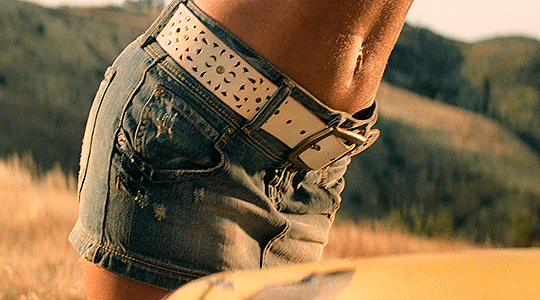
this other gif. like yes mommy
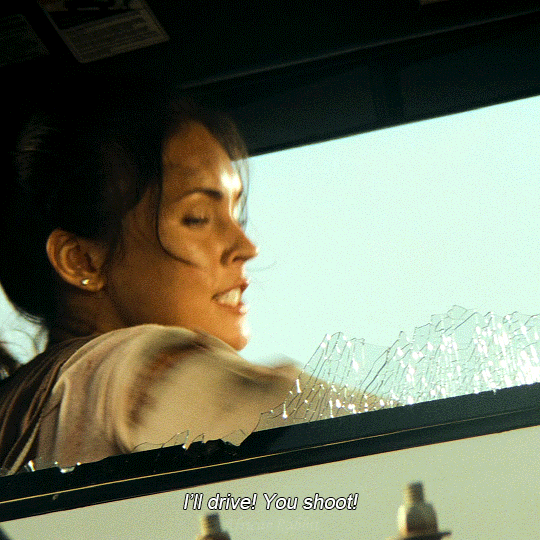
bro was really out here just living his transfem dream like HELLO???? the NAME?????
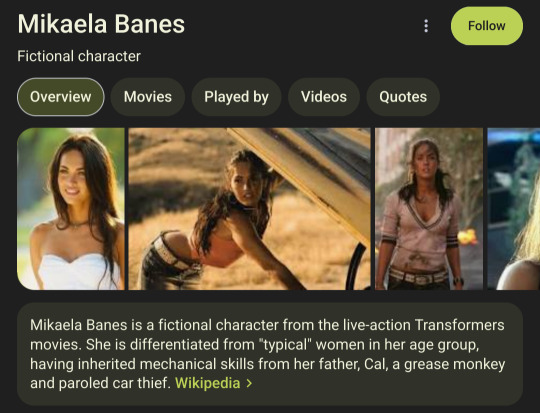
this graphic i made ab how mikaela walked so asami could DRIVE (and thus be the first queer couple in a western kids' show; normalizing representation):
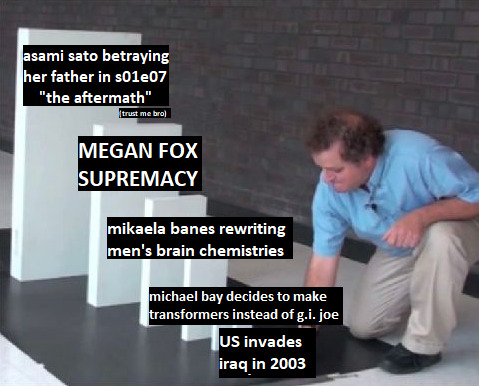
(something something the dominos fall all the way to caitvi sex scene something)
now that we're on the topic, mikaela banes vs. asami sato venn diagram:
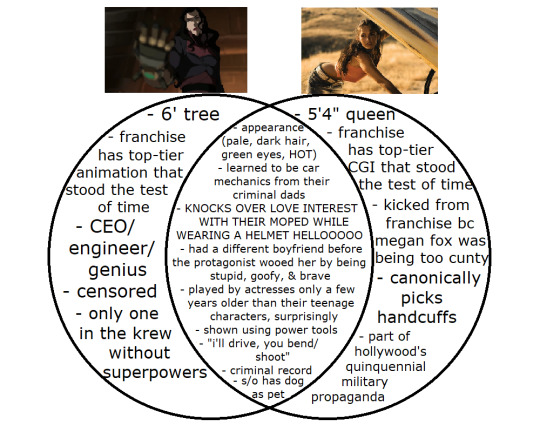
LIKE ARE THESE NOT THE EXACTTTTT SAME CONVERSATION:
shia labeouf is purely acting out all of korra's intrusive thoughts if she let them win lmaooooooo
anyway michael bay either did or didn't know what he was doing. but there is an abundance of lesbians nonetheless. 👀👀
#asami sato: *exists*#me: close enough. welcome back mikaela banes!#WAS NO ONE GOING TO TELL ME THAT DREAMWORKS HELPED TO PRODUCE TRANSFORMERS#OR WAS I JUST SUPPOSED TO WATCH THE DREAMWORKS LOGO ANIMATION TO TRANSFORMERS SOUNDS MYSELF#me holding a sign that says “I AM NOT IMMUNE TO HOT WOMAN PROPAGANDA” (bc i loveeeeeeee transformers 2007)#also. shia labeouf acted tf outta this role can i just say.#little did my dad know that repeated exposure to this movie was only priming me for the gayest lesbian of all time lmaooooooo#michael bay#mikaela banes#lesbianism#asami sato#the fact that this is the third time i've made venn diagrams comparing asami to characters from other franchises.......#.....................#*cough* simp *cough*#transformers (2007)#transformers#lok#megan fox
37 notes
·
View notes
Text
An Open Letter to Voltron: Legendary Defender and DreamWorks
AUTHOR: @astralsheith
SOURCE: https://twitter.com/astralsheith/status/1074317099730919424
READ ON WORDPRESS
What happened to Voltron?
Back in October, screenshots from the final episode of Voltron’s eighth and final season were leaked online. The fandom split down the middle regarding who thought they were real and who thought they were fake and bad behaviour sprung up from both sides. I tried to maintain as neutral a stance as possible, waiting for an official statement to be made but none ever came and confirmation on the leaks came when the final season dropped on Netflix on December 14th. I had always remained hopeful that the leaks were fake, because the implications of them were troubling to me, such as Allura dying and Shiro’s last-minute wedding. My trust in Voltron’s showrunners (Lauren Montgomery and Joaquim Dos Santos) and creative team’s storytelling kept me going and I was, ultimately, excited (if sad about Voltron ending) to see the last season of a show I hold close to my heart.
Lo and behold, here we are, and it is somehow worse than I thought possible.
I can’t say that I hated Season 8. They were some stunning and powerful moments, to be sure, and as always, Studio Mir’s animation was incredible and breathtaking. The documentary episode was clever, dynamic, and brilliantly animated. Honerva’s arc as the show’s final villain was, in my opinion, one of the strongest points of the season. But when the dust settled after I’d finished watching I realised how disappointed and hurt I felt by this season. How, in the end, Voltron’s final season largely felt...hollow. As if the passion and heart that had been put into the previous seven seasons had been lost or smothered somehow. And the air of silence from the showrunners, the cast and crew that has bookended both the build up and response to Season 8 feels not only deafening but damning to how this final season ultimately turned out. Both the cast and crew and the fandom should be celebrating. The show ending may be bittersweet but ultimately, we should be celebrating the successful final season of an incredible show that has given so much to so many people.
Instead, people are crying - out of disappointment, hurt, a sense of betrayal. People are physically sick. Unable to eat. Unable to sleep. Children (Voltron’s supposed target demographic) are upset and confused by what transpired in Season 8.
What happened? What happened between SDCC of this year - when the cast and crew seemed so alight with passion and love for the show and the fact that they’d achieved the momentous feat of having a queer main character like Shiro - and now, with a final season that has left fans in pieces and its showrunners seemingly running as fast as they can from what their beloved show ended up being? For what purpose is this the outcome? Did LM and JDS get tired after working for so long on this show? Did they bite off more than they could chew? Did DreamWorks and other IP holders decide to, ultimately, take matters into their own hands and mold the final season into the Voltron they’d wanted all along? Robot action, transformation sequences, power-ups - those are all amazing if there’s some meaning behind them. That did not seem to be the case in Season 8. Season 8 was something separate in terms of its story and its characters than what had been developed in Seasons 1 through 7.
What happened to Voltron?
There are several things that are wrong with Season 8 that I could discuss. How about I start with Shiro? Shiro is my favourite character in Voltron and has been from since I started watching the show. At first glance, he might seem the prototypical hypermasculine and stoic leader type but there was such a kindness to him, a willingness to look out for his team no matter the cost, that made him different. An ambition to explore the universe and a passion to help people in need. A sense of humor that was dorky and dark in equal measure. He dealt with trauma. He faced immense adversity. Yet he survived. More than that, by the end of Season 7, he seemed to be thriving. Former Black Paladin of Voltron and current Captain of the IGF Atlas. And he was a gay man - a gay man not defined by his sexuality by any means. There has always been so much more to Shiro than meets the eye. Except in Season 8 - in Season 8, for the most part, all that made Shiro so wonderful as a character in a so-called kid’s show was...gone. He was “Captain”. He shouted orders and directions and rarely did his personality get any real chance to shine. The arm-wrestling in the episode Clear Day was probably the most engaging Shiro was as a character in the entire thirteen episodes. He didn’t have to be the focus of the season - that was clearly Allura and Honerva and that’s great - but he should still have been the character we’ve come to know and love and admire over the last two years or so. But he wasn’t. He just wasn’t.
Furthermore (and I am well aware I might just get written off as a “spiteful shipper” for this), the relationship between Shiro and Keith in Season 8 all but vanished. Putting aside the question of whether Shiro and Keith being canon as a romantic couple was ever on the table for Voltron, their strong friendship was all but erased from Voltron’s “canon” in Season 8. This is a relationship that has been a pillar of the show since the very beginning. Keith’s introduction to the show was him saving Shiro. His first bit of dialogue on the show was Shiro’s name. They’ve had near-entire episodes dedicated to their relationship - Across the Universe, The Blade of Marmora, The Black Paladins, A Little Adventure. What other duo in Voltron can boast that? Maybe Zarkon and Honerva but not even they - as two of the main villains of the show and the catalyst for the entire war that takes place throughout Voltron’s story and plot - have that much plot and character attention as Shiro and Keith have had regarding their bond. Shiro and Keith have soundtracks specific to their relationship.
What could possibly have happened to warrant the kind of erasure they faced in Season 8? How is it I can point to several moments throughout Season 8 where Shiro and Keith’s relationship could have continued to shine yet there was almost nothing there? Was it censorship? Was DreamWorks and Co. unable to handle a gay main character having a close relationship with his male best friend? Because it certainly feels like that’s the case - a fear of what Shiro and Keith could have been by the end of Voltron (even as best friends) and a desperation to backpedal. Was it “think of the children”? Yet how are you “thinking of the children” when Lotor’s melted corpse is allowed on screen? Is body horror and violence “safe” for children but meaningful relationships involving queer main characters are not?
And then there’s Shiro’s wedding in the “epilogue”. I won’t deny that the image of a gay main character such as Shiro, marrying and kissing another man, isn’t (on the surface) powerful in its own way and could perhaps prove to be a gateway to more male queer representation in Western animation. Yet when that man is a man I only the know name of because I watch Voltron with captions, when that man is mistaken for Shiro’s dead ex partner by Netflix’s audio description, when that man is marrying Shiro at the seeming expense of Shiro’s entire character, it can’t help but feel cheap. A PR stunt for “representation points”. A quick-fix due to the backlash Voltron faced after Season 7 and Adam’s death. There’s no weight or true meaning behind it. No development. The fact that Voltron’s supervising producer last work for Voltron that he posted on his Instagram was him drawing and animating Shiro’s wedding weeks (September 13th) after said backlash kicked off (mid-late August) does not feel unrelated or coincidental to me. It doesn’t feel genuine. It doesn’t feel true to the story Voltron’s been telling these past 2 ½ half years.
Allura. Oh, Allura.
I can’t think of a solid reason why the decision was made to kill Allura off. I’d like to think that the original idea was to have Voltron be sacrificed but DreamWorks was reluctant to let go off the eponymous robot and Allura was the only character close to powerful enough to be convincing of rebooting all realities, along with Honerva. But who's to say that’s even close to the truth? And why not have it be solely Honerva? I would have believed that if they were truly committed to a “redemption in death” for Honerva. Why Allura? Why go against Allura’s character of arc of moving away from destructive self-sacrifice, learning to trust her team, finding a new family in the paladins? Why have the paladins so readily accept Allura’s decision? “We are always stronger together” - yet Allura is the only paladin to sacrifice herself? She faced so much loss as a character - why have her lose her life, too? Allura was never meant to be a martyr. She was meant to live. To move past her father’s legacy and help rebuild the universe. Lead her people. Experience Altea again. And the relationship between Allura and Lance in Season 8 was wonderful and sweet but in light of Allura’s death can’t help but feel somewhat contrived for maximum emotional impact when they say goodbye. Allura’s death, ultimately, felt unnecessary, unfair, and ill aligned with what I thought were Voltron’s primary themes. Power of love, of friendship and family, of teamwork. What’s the point of a team if, in the end, they do very little to help save the universe and the burden is left on one person alone?
And the rest of the team in Season 8 suffered, too. Pidge barely interacted with any of the other paladins. Hunk displayed some great moments with his love of cooking and how that helped people but the heroics he displayed in Season 7 seemed to fall to the wayside. Lance’s signature goofiness seemed to get lost in his constant worry over Allura. I am grateful for his newfound maturity but it shouldn’t come at the expense of what made these character so distinct in the first place.
I have loved Voltron. I still do, even if I am currently working through these difficult emotions regarding its final season. I have defended it in the past from irrational “critique”. Seven seasons of great storytelling does not vanish in the wake of a troubling and disappointing ending. At some point, I will continue with my rewatch. Right now, I think that would be difficult. I’m not trying to point specific blame at any one person or party in particular, as I don’t know the truth of what happened during Voltron’s production (as much as I would like to). I just know that Season 8 felt like a lie. Not only a lie but a bad lie. A transparent lie. And I and so many other dedicated fans would greatly appreciate the truth. I don’t need to see what Season 8 would have originally been, if there is such a thing. I can honestly quite easily imagine it, because Voltron’s previous seasons had set it up so thoughtfully. But I would be grateful for an explanation, for a break in the silence, for someone involved with the show to come forth and help the fandom move forward in the wake of Season 8.
What happened to Voltron? Tell us, because we’re ready to listen.
32 notes
·
View notes
Text
Good vs Great: Details Matter
So with the release of the new Thor movie I thought it would be appropriate to write a post celebrating one of the greatest superhero movies of all time. Released before the genre really got popular, it has everything one could hope for in an action flick: Strong character and story, tense action, and timeless themes. The movie wasn’t produced by Marvel, DC, or even Fox.
It was Pixar. Pixar made the best superhero movie, and I will fight anyone who disagrees.

Like most things I write about, I absolutely love this movie. I remember seeing the trailers for it way back in 2004 and was obsessed even before it was released. As a middle schooler I sought out reviews and merchandise, and even clipped out an interview with director Brad Bird out of a newspaper. I got the two-disk special edition as soon as it came out and watched every special feature and both commentaries...more than once.
So usual disclaimer: I will try to keep my clearly unhealthy bias under control, but no promises.
Before going too deeply into why I think The Incredibles is such an, er, incredible movie I think it would help to compare it to another animated family film that covers a lot of the same narrative themes but without the same emotional weight.
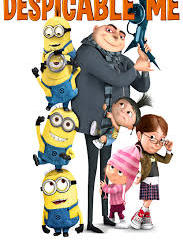
To be clear, I don’t think the first Despicable Me movie is bad, but many (myself included) consider The Incredibles to be one of Pixar’s best movies and a classic in its own right. The question here is what elevates The Incredibles from good to great, and I think the devil’s in the details.
Pushing Boundaries
One thing that becomes clear when watching the commentaries for The Incredibles was that it was freaking hard to animate. Remember, this was back in 2004. Pixar had never made a movie starring humans. They had no idea how to do long hair (Violet) or heavy muscle/feats of strength (Mr. Incredible). Budget constrictions limited the number of “universal men” the animators could use for crowd scenes. In fact, Bomb Voyage actually shares a character model with Frozone, albeit slightly modified.
That’s just the human characters. Water and fire are both difficult to animate, and The Incredibles has its fair share of both. And remember the opening montage, when Mr. Incredible’s car transforms into the Batmobile? That was difficult, time-consuming animation and it shows up twice, and never outside of the opening (it would have been once, but the animators felt if they were going to go through all that effort they might as well make it worth their while.)
And behold, one of the most technically difficult scenes to animate in the entire movie
youtube
I know, I was surprised too, but it seems the act of Bob and Edna putting their hand through the ripped suit gave the animators fits. Apparently they asked Bird if there was a way they could cut around actually showing the action itself because it was so damned hard.
I will be the first to admit that being technologically innovative does not always lead to a good movie, but there’s something to be said about pushing the boundaries and just seeing what happens. With a budget of $92 million it wasn’t as if Bird and his team were working with peanuts, but they did everything they could to make the best use of their money.
Despicable Me does have a strong aesthetic that separates it from Pixar or DreamWorks, and these visuals are a good fit for the tone of the story. The exaggerated proportions of the characters is right at home in the zany world that they live in. I don’t think Gru’s daft plan to steal the moon would have worked as well in a film with a more traditional Pixar look.
But as far as animation quality goes, there’s nothing particularly special with Despicable Me. To some degree this makes sense. Despicable Me had fewer resources to work with. It was Illumination’s first feature film, and a flop could have sunk their studio.
Despicable Me is a fun little romp, but it also plays it very safe. The story is by the numbers, and it does enough for the warm fuzzies at the end to feel earned. It is very much a kid’s movie, without ever thinking too deeply into its characters or the natural consequences of their actions.
The Incredibles is an animated film, but it doesn’t really feel like a kid’s movie - and in fact Brad Bird caught some flack for some of the violence and dark implications of the film. It does not pander to children.
With that in mind, look at this scene between Helen and Bob
youtube
I bring this up to show some of the nuance that goes into visual storytelling. Any married couple could tell you that Bob and Helen are not really arguing about Dash here. This is a long-standing conflict that’s been simmering for years, and it highlights the effects Bob’s major character flaw has on the family.
All of that is found in the script. It’s a scene that could be found in a movie, book, or play. While well-written, there’s a universality to it. It was up to Bird to add something to this scene that I think only works in an animated film.
Look again at the end of the scene. When Helen shouts “It’s not about you!” she uses her stretchy power to tower over her more physically imposing husband. It’s such a tiny detail, but it completely changes the dynamic of the argument and their relationship as a married couple.
And apparently figuring out this scene was so memorable that producer John Walker mentioned it in the commentary and Edwin Catmull (current president of Pixar animation studios) specifically brought it up in his book Creativity, Inc

(I have somewhat...eclectic tastes in literature)
And this is what I really mean about pushing boundaries to bring out the best of a story. You don’t need millions of dollars to animate a husband and wife arguing, but you do have to pay attention to what they’re saying and how they’re saying it to 1) make sure it fits the plot/tone of the movie you’re going for, and 2) have it feel real/authentic to the audience.
I didn’t ever get this feeling of authenticity from Despicable Me, and it’s not just because of it’s overall more light-hearted tone. Kung Fu Panda was loaded with humor and had its protagonist voiced by Jack Black and it still managed to have more emotional depth. The world and the majority of the characters who live in Despicable Me are flat and one-note.
The biggest example can be found in the girls Gru ends up adopting. For one, Edith has no impact on the movie whatsoever. She could have been cut and nothing would have changed. To me that proves that the girls could have been given more depth.
Secondly, the effects of Miss Hattie’s abuse are never really explored. If anything it’s played for dark comedy
youtube
With this scene alone Illumination had the setup for a truly despicable, Dolores Umbrige-style villain, but nothing ever comes if it. The movie wastes run time with a montage of the minions going out shopping, but it can’t be bothered to tell us that Margo, Edith, and Agnes aren’t actually blood siblings or how they came to be as inseparable as they are.
The Incredibles is a movie about a man reconnecting with his family trapped in the guise of a superhero flick. As Brad Bird said, it’s the fantastic and the mundane smashed together into something that’s both awesome and very human.
Despicable Me had the potential to do the same, this time exploring a non-traditional family structure, foster care and adoption, and the difficulties of being a single parent. And don’t get me wrong, it does do some of those things, but often they take a back seat to the more superficial aspects of the story. Illumination didn’t plum the depths of their concept like Pixar did with theirs, and that’s the difference between being good and greatness.
#The Incredibles#Despicable Me#Pixar#illumination studios#Mr. Incredible#Bob Parr#Elastigirl#Helen Parr#Gru#Margo#Edith#Agnes#Writing#Animation#creative-type analyzes
23 notes
·
View notes
Link
I’ve been very lucky to have been in the animation industry since the mid-1980s, and I have lived through my share of big disruptions — most of them having to do with new technologies. What’s going on today is as significant as anything I’ve seen before, but it’s being driven by a whole new set of forces.
Here’s a quick survey of trends in the animation landscape that have me pretty optimistic about the future.
Technology is vanishing
By “vanishing,” I don’t mean going away; I mean disappearing from view. I’ve always said, “When technology can disappear, that’s when creativity can really begin.”
For the past 20 years, feature-film animation in particular has been an arms race of studios like Pixar and DreamWorks trying to out-engineer each other to deliver high-end character performances and visual effects that no one had ever seen. As a result, studios spent tens of millions of dollars becoming, essentially, IT companies with teams of creators producing stories to demonstrate their latest breakthroughs. Now, thanks to simpler, more intuitive tools, technology is becoming less intrusive in the creative process and animators can finally get back to doing what they love: telling stories.
New distribution platforms are driving demand
The explosion of new outlets on cable, over-the-top and online, is creating unprecedented opportunities for animated content in a wide range of styles, genres and formats. Netflix has found an audience for all kinds of quirky original animated programs, and its competitors are following suit. Cable networks are pushing the envelope in all kinds of ways, as well.
These new channels are opening up the world to artists and studios. Now anyone can create a compelling story in their basement and the world will have a chance to see it. And if it finds its audience, it can be as big as any studio release. Never before has that been possible.
Digital imagery is invading the physical world
If you love animation and digital imagery, you’re no longer limited to watching it on a screen. It’s spilling out into the world around us on mobile devices, augmented and virtual reality headsets, immersive smart spaces, holograms, giant flat panels and who knows what’s next?
The thing is, most of those hardware innovations are still waiting for their “killer app” — that must-have content or experience that pulls audiences to the new ways of experiencing stories. I firmly believe that animation and visual storytelling is going to drive those killer apps, particularly in VR.
Globally distributed workflow is transforming teamwork
The idea of a global distributed workforce isn’t new to most businesses, but it’s somewhat new for animation production. Sure, offshore outsourcing has been happening for years, but animation, at its best, is massively collaborative. Teams have to collaborate and share their ideas to help a story reach its full potential. Until recently, the connective technology hasn’t been up to the task. Now, at last, the cloud makes a lot of those limitations obsolete. It doesn’t matter if your teammate is sitting at the next desk or in Seoul, Dublin or Mexico City. And that means…
New voices are joining the conversation
All these trends are lowering the barriers and cost to entry for upstarts around the world. That means we’ll be hearing from lots of people and perspectives that haven’t been part of the animation industry before. In a world where creativity is the coin of the realm, that means we’re all going to be a whole lot richer.
via TechCrunch
0 notes
Text
Interview with Christophe Vacher: Art Director, Concept Artist & Painter
Christophe Vacher is a two-time Emmy Award winner, an Art Director, Concept Artist & Painter, he has worked with companies such as Disney, DreamWorks, Universal Studios and the film industry since 1989. He worked on projects such as Treasure Planet, Fantasia 2000, Hercules, Tarzan and the animated segment on the Disney live movie Enchanted and on the CG feature film “9” produced by Tim Burton and was nominated for an Annie Award (the equivalent of the Academy Award in animation) and also worked in the visual development of Despicable Me and is currently working for Hasbro studios on the CG animated Transformers TV series.
(Be sure to watch the video interview below!)
Christophe Vacher also works on paintings for art galleries and collectors from all over the world. He’s originally from France where he started his career in animation and eventually moved to Los Angeles to work and learn more about art and animation. He taught himself most of his skills and on the side he also travels the world and has studied many martial arts like Judo, Viernamese and Chinese Kung Fu, Karate, Savate-French Boxing, Yoseikan Budo, Taekwondo, English boxing, Kickboxing, Jeet Kune Do, and many more. He also practices Swing dancing, Salsa, horseback riding and cooking. So Christophe has learned a lot of tricks on how to manage time and learning many skills.
You can check her work here: His Website His Deviant Art His Fan Page His Instagram His Twitter Famous Artists School Click to view slideshow.
Interview with Cristophe Vacher:
youtube
(Click the play button to watch the video interview above)
Click here to watch in a new Tab: https://www.youtube.com/watch?v=RkMO7JjHc_4
In this Episode, You Will Learn:
Cristophe Vacher’s Story
How to work in a team
How to become a great artist without spending much
The right attitude as a creative professional
Online resources to use
Actionable Steps
If you have to explain what your art is about then you still don’t have enough skill, your art should tell the story, people should understand by seeing it.
Beware of art schools that will rip your money and time and won’t leave you with any real skill to become an artist, you don’t need a degree to live from this.
When working on a team you need to learn to manage your ego, in a team, the work is not about the art, is about the project and inspiring your team members to create that works in harmony, be a nice person, be a nice player.
When you create your portfolios, keep them simple, 15 to 20 works at most. And it has to be your best work, from the best to the lest greatest.
You can use the internet to your favor, you can learn from the best of the world for free or by paying little, you don’t need to go into $50K in debt to become a great artist.
“IGNORING THE ENTREPRENEURSHIP ASPECT OF BEING AN ARTIST IS RIDICULOUS”
Did You Enjoy This Interview? Let Us Know On Twitter!
If you enjoyed this interview, please let Cristophe and I know on Twitter by clicking on the link below:
Click here to let us know you loved the show!
Now it’s Your Turn!
Got questions or any advice or thoughts you want to share about this interview or anything you learned that helped you on your way to freedom? What’s one thing you can take from Cristophe Vacher’s Journey? Please feel free to share in the comments section below!
Thanks so much for watching the interview with Cristophe Vacher, I truly appreciate YOU!
Until Next Time!
Rodrigo
The post Interview with Christophe Vacher: Art Director, Concept Artist & Painter appeared first on Frame Freak Studio.
from Frame Freak Studio http://ift.tt/2giDQuW via http://ift.tt/2fNRIgQ
0 notes